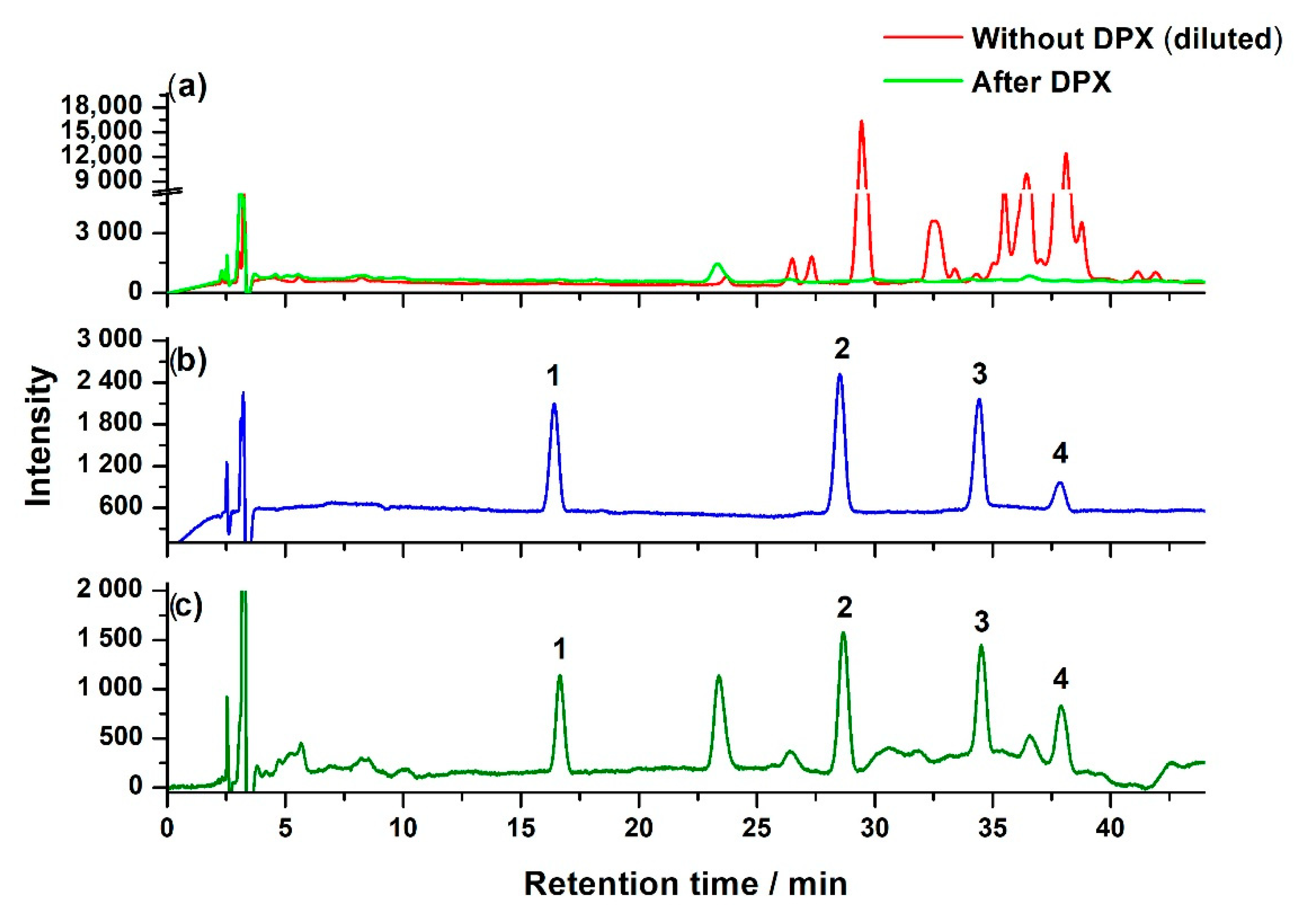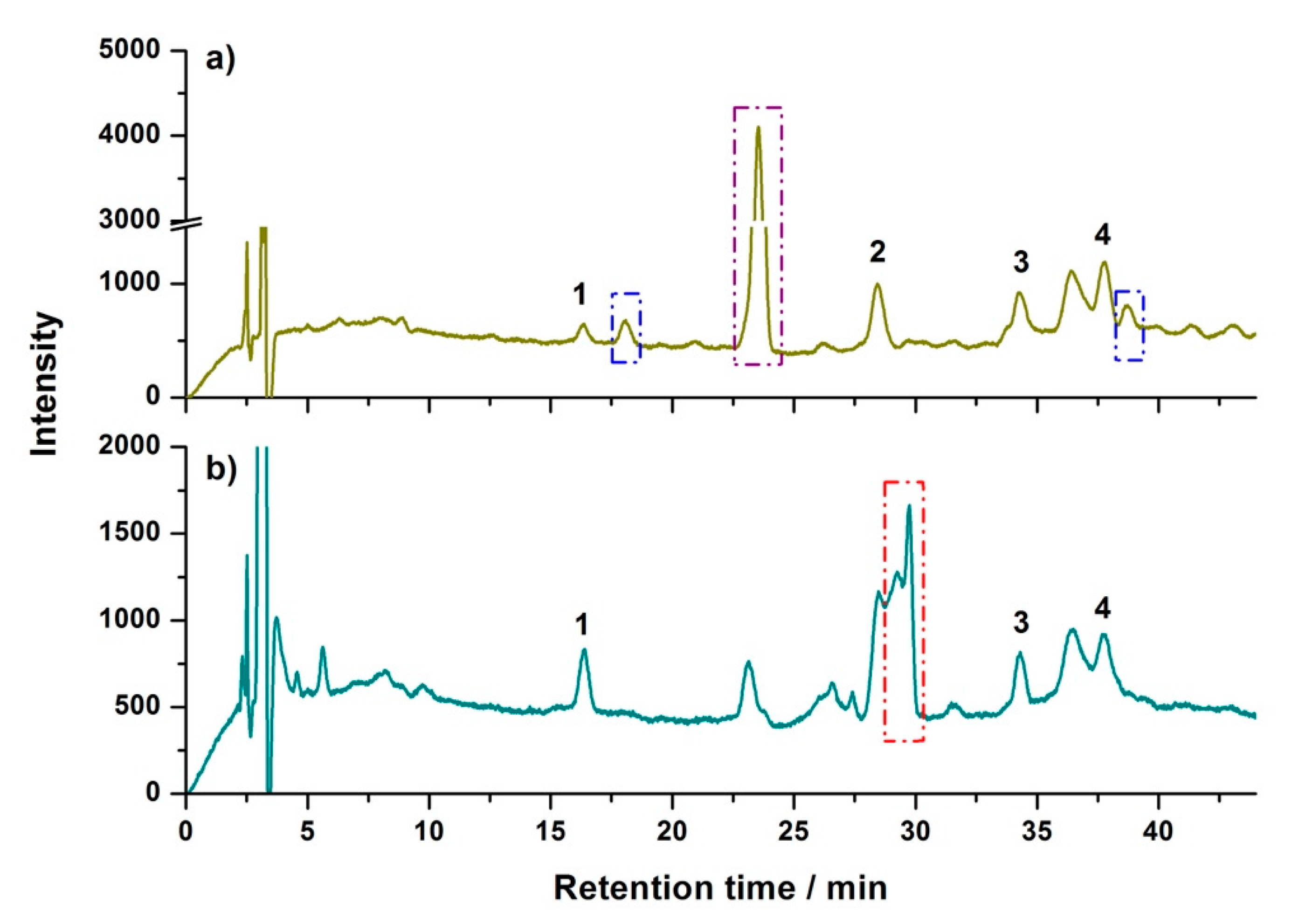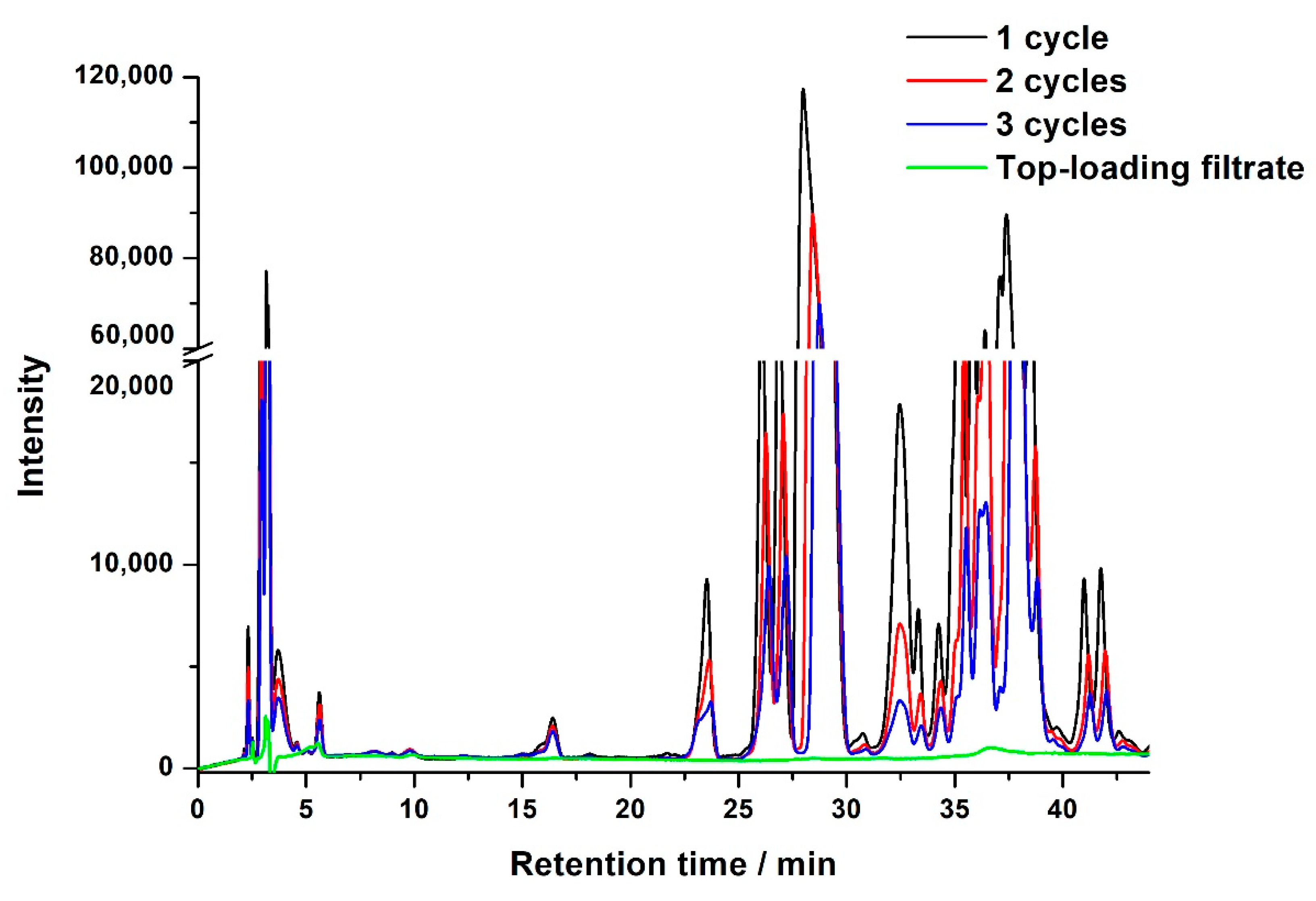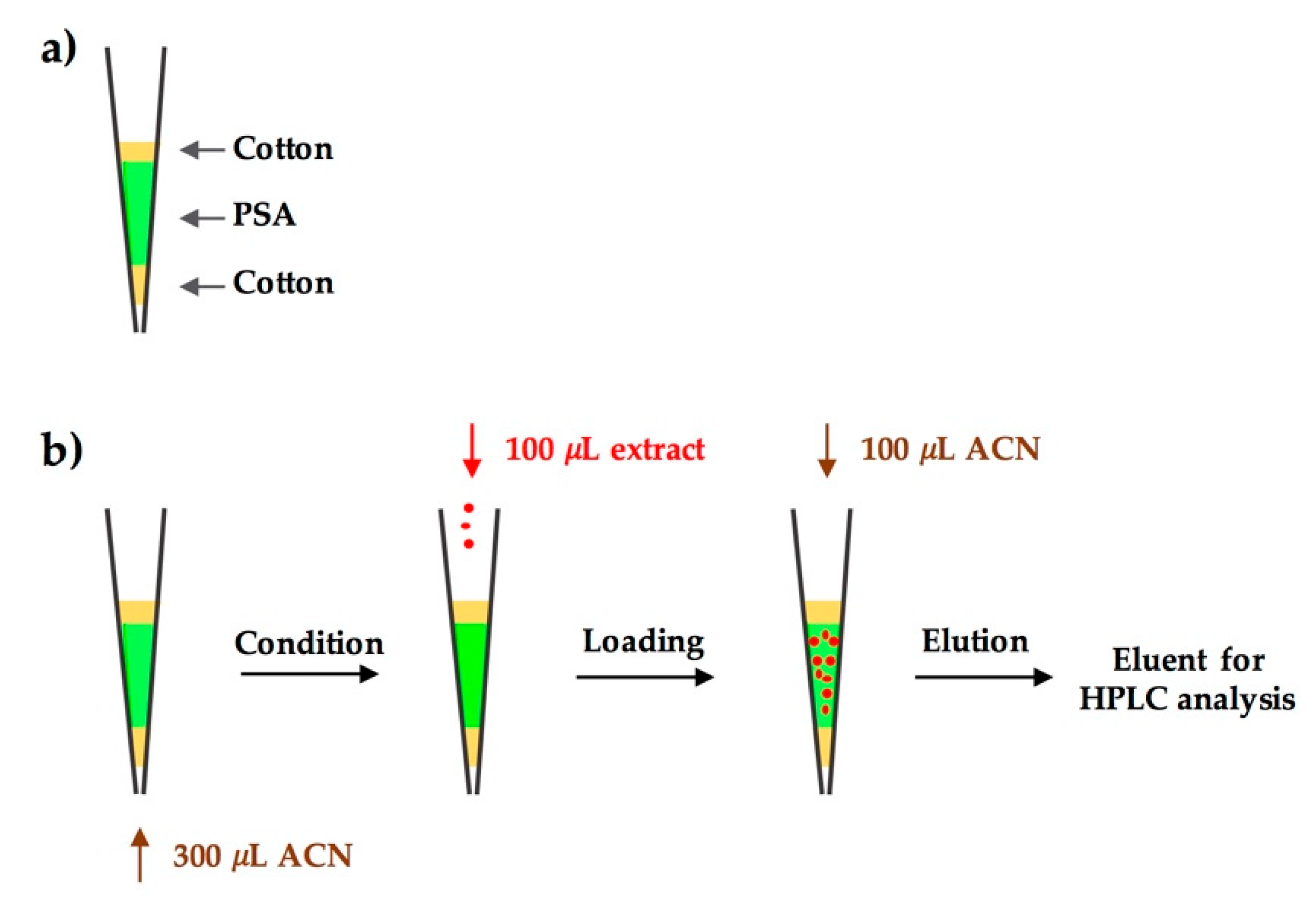Miniaturized Salting-Out Assisted Liquid-Liquid Extraction Combined with Disposable Pipette Extraction for Fast Sample Preparation of Neonicotinoid Pesticides in Bee Pollen
Abstract
1. Introduction
2. Results and Discussion
2.1. Salting-Out Assisted Liquid-Liquid Extraction
2.2. DPX Clean-Up
2.3. Analytical Performance
3. Materials and Methods
3.1. Materials
3.2. Salting-Out Assisted Liquid-Liquid Extraction
3.3. DPX Clean-Up
3.4. Study of DPX Procedure
3.4.1. Comparing Matrix Solution without DPX Clean-Up
3.4.2. Effect of Different Sorbents
3.4.3. Effect of the Mass of PSA
3.4.4. Effect of Elution Solvent
3.4.5. Comparing Draw-In Sample Loading Mode
3.4.6. Comparing d-SPE
3.5. HPLC Analysis
3.6. Method Validation
4. Conclusions
Supplementary Materials
Author Contributions
Funding
Conflicts of Interest
References
- Neumann, P.; Carreck, N.L. Honey bee colony losses. J. Apic. Res. 2010, 49, 1–6. [Google Scholar] [CrossRef]
- Goulson, D.; Nicholls, E.; Botías, C.; Rotheray, E.L. Bee declines driven by combined stress from parasites, pesticides, and lack of flowers. Science 2015, 347, 1255957. [Google Scholar] [CrossRef]
- Campos, M.R.G.; Bogdanov, S.; de Almeida-Muradian, L.M.B.; Szczesna, T.; Mancebo, Y.; Frigerio, C.; Ferreira, F. Pollen composition and standardisation of analytical methods. J. Apicult. Res. 2008, 47, 156–163. [Google Scholar] [CrossRef]
- Mao, W.; Schuler, M.A.; Berenbaum, M.R. Honey constituents up-regulate detoxification and immunity genes in the western honey bee Apis mellifera. Proc. Natl. Acad. Sci. USA 2013, 110, 8842–8846. [Google Scholar] [CrossRef] [PubMed]
- Tu, X.; Chen, W. Overview of Analytical Methods for the Determination of Neonicotinoid Pesticides in Honeybee Products and Honeybee. Crit. Rev. Anal. Chem. 2020, in press. [Google Scholar] [CrossRef] [PubMed]
- Yáñez, K.P.; Martín, M.T.; Bernal, J.L.; Nozal, M.J. Trace Analysis of Seven Neonicotinoid Insecticides in Bee Pollen by Solid-Liquid Extraction and Liquid Chromatography Coupled to Electrospray Ionization Mass Spectrometry. Food Anal. Methods 2014, 7, 490–499. [Google Scholar] [CrossRef]
- Zhang, L.; Wang, Y.; Sun, C.; Yang, S.; He, H. Simultaneous Determination of Organochlorine, Organophosphorus, and Pyrethroid Pesticides in Bee Pollens by Solid-Phase Extraction Cleanup Followed by Gas Chromatography Using Electron-Capture Detector. Food Anal. Methods 2012, 6, 1508–1514. [Google Scholar] [CrossRef]
- López-Fernández, O.; Rial-Otero, R.; Simal-Gándara, J. High-throughput HPLC-MS/MS determination of the persistence of neonicotinoid insecticide residues of regulatory interest in dietary bee pollen. Anal. Bioanal. Chem. 2015, 407, 7101–7110. [Google Scholar] [CrossRef]
- Vazquez-Quintal, P.E.; Rodríguez, D.M.; Medina-Peralta, S.; Moguel-Ordóñez, Y.B. Extraction of Organochlorine Pesticides from Bee Pollen by Matrix Solid-Phase Dispersion: Recovery Evaluation by GC-MS and Method Validation. Chromatographia 2012, 75, 923–930. [Google Scholar] [CrossRef]
- Vázquez, P.P.; Lozano, A.; Uclés, S.; Ramos, M.G.; Fernández-Alba, A.R. A sensitive and efficient method for routine pesticide multiresidue analysis in bee pollen samples using gas and liquid chromatography coupled to tandem mass spectrometry. J. Chromatogr. A 2015, 1426, 161–173. [Google Scholar] [CrossRef]
- Li, Y.; Kelley, R.A.; Anderson, T.D.; Lydy, M. Development and comparison of two multi-residue methods for the analysis of select pesticides in honey bees, pollen, and wax by gas chromatography-quadrupole mass spectrometry. Talanta 2015, 140, 81–87. [Google Scholar] [CrossRef] [PubMed]
- Bernal, J.; Nozal, M.J.; Martín, M.T.; Bernal, J.L.; Ares, A.M. Trace analysis of flubendiamide in bee pollen using enhanced matrix removal-lipid sorbent clean-up and liquid chromatography-electrospray ionization mass spectrometry. Microchem. J. 2019, 148, 541–547. [Google Scholar] [CrossRef]
- Valente, I.M.; Rodrigues, J.A. Recent advances in salt-assisted LLE for analyzing biological samples. Bioanalysis 2015, 7, 2187–2193. [Google Scholar] [CrossRef] [PubMed]
- Schroeder, J.L.; Marinetti, L.J.; Smith, R.K.; Brewer, W.E.; Clelland, B.L.; Morgan, S.L. The analysis of delta9-tetrahydrocannabinol and metabolite in whole blood and 11-nor-delta9-tetrahydrocannabinol-9-carboxylic acid in urine using disposable pipette extraction with confirmation and quantification by gas chromatography-mass spectrometry. J. Anal. Toxicol. 2008, 32, 659–666. [Google Scholar] [CrossRef] [PubMed]
- Bordin, D.C.M.; Alves, M.N.R.; De Campos, E.G.; De Martinis, B.S. Disposable pipette tips extraction: Fundamentals, applications and state of the art. J. Sep. Sci. 2016, 39, 1168–1172. [Google Scholar] [CrossRef]
- Guan, H.; Brewer, W.E.; Garris, S.T.; Morgan, S.L. Disposable pipette extraction for the analysis of pesticides in fruit and vegetables using gas chromatography/mass spectrometry. J. Chromatogr. A 2010, 1217, 1867–1874. [Google Scholar] [CrossRef]
- Guan, H.; Brewer, W.E.; Morgan, S.L. New Approach to Multiresidue Pesticide Determination in Foods with High Fat Content Using Disposable Pipette Extraction (DPX) and Gas Chromatography−Mass spectrometry (GC-MS). J. Agric. Food Chem. 2009, 57, 10531–10538. [Google Scholar] [CrossRef]
- Scheidweiler, K.B.; Newmeyer, M.N.; Barnes, A.J.; Huestis, M.A. Quantification of cannabinoids and their free and glucuronide metabolites in whole blood by disposable pipette extraction and liquid chromatography-tandem mass spectrometry. J. Chromatogr. A 2016, 1453, 34–42. [Google Scholar] [CrossRef]
- Mastrianni, K.R.; Metavarayuth, K.; Brewer, W.E.; Wang, Q. Analysis of 10 β-agonists in pork meat using automated dispersive pipette extraction and LC-MS/MS. J. Chromatogr. B 2018, 1084, 64–68. [Google Scholar] [CrossRef]
- Bordin, D.C.M.; Alves, M.N.; Cabrices, O.G.; De Campos, E.G.; De Martinis, B.S. A Rapid Assay for the Simultaneous Determination of Nicotine, Cocaine and Metabolites in Meconium Using Disposable Pipette Extraction and Gas Chromatography-Mass Spectrometry (GC-MS). J. Anal. Toxicol. 2013, 38, 31–38. [Google Scholar] [CrossRef]
- Pinto, M.A.L.; De Souza, I.D.; Queiroz, M.E.C. Determination of drugs in plasma samples by disposable pipette extraction with C18-BSA phase and liquid chromatography-tandem mass spectrometry. J. Pharm. Biomed. Anal. 2017, 139, 116–124. [Google Scholar] [CrossRef] [PubMed]
- Samanidou, V.F.; Stathatos, C.; Njau, S.; Kovatsi, L. Disposable pipette extraction for the simultaneous determination of biperiden and three antipsychotic drugs in human urine by GC-nitrogen phosphorus detection. Bioanalysis 2013, 5, 21–29. [Google Scholar] [CrossRef] [PubMed]
- Lehotay, S.J.; Mastovska, K.; Lightfield, A.R.; Nuñez, A.; Dutko, T.; Ng, C.; Bluhm, L. Rapid analysis of aminoglycoside antibiotics in bovine tissues using disposable pipette extraction and ultrahigh performance liquid chromatography-tandem mass spectrometry. J. Chromatogr. A 2013, 1313, 103–112. [Google Scholar] [CrossRef] [PubMed]
- Chaves, A.R.; Moura, B.H.; Caris, J.A.; Rabelo, D.; Queiroz, M.E.C. The development of a new disposable pipette extraction phase based on polyaniline composites for the determination of levels of antidepressants in plasma samples. J. Chromatogr. A 2015, 1399, 1–7. [Google Scholar] [CrossRef] [PubMed]
- Oenning, A.L.; Merib, J.; Carasek, E. An effective and high-throughput analytical methodology for pesticide screening in human urine by disposable pipette extraction and gas chromatography-mass spectrometry. J. Chromatogr. B 2018, 1092, 459–465. [Google Scholar] [CrossRef] [PubMed]
- Zhang, H.; Li, Y.; Zhu, J.; Li, H.; Li, D.; Liu, Z.; Sun, X.; Wang, B.; Wang, Q.; Gao, Y. Disposable Pipette Extraction (DPX) Coupled with Liquid Chromatography-Tandem Mass Spectrometry for the Simultaneous Determination of Pesticide Residues in Wine Samples. Food Anal. Methods 2019, 12, 2262–2272. [Google Scholar] [CrossRef]
- Júnior, C.A.S.A.; Dos Santos, A.L.R.; De Faria, A.M. Disposable pipette extraction using a selective sorbent for carbendazim residues in orange juice. Food Chem. 2020, 309, 125756. [Google Scholar] [CrossRef]
- Tan, S.C.; Lee, H.K. Graphitic carbon nitride as sorbent for the emulsification-enhanced disposable pipette extraction of eight organochlorine pesticides prior to GC-MS analysis. Microchim. Acta 2020, 187, 1–10. [Google Scholar] [CrossRef]
- Fernandes, V.C.; Domingues, V.F.; Mateus, N.; Delerue-Matos, C. Multiresidue pesticides analysis in soils using modified QuEChERS with disposable pipette extraction and dispersive solid-phase extraction. J. Sep. Sci. 2012, 36, 376–382. [Google Scholar] [CrossRef]
- Lu, Z.; Fang, N.; Zhang, Z.; Hou, Z.; Lu, Z.; Li, Y. Residue analysis of fungicides fenpicoxamid, isofetamid, and mandestrobin in cereals using zirconium oxide disposable pipette extraction clean-up and ultrahigh-performance liquid chromatography-tandem mass spectrometry. J. Chromatogr. A 2020, 1620, 461004. [Google Scholar] [CrossRef]
- Cadorim, H.R.; Schneider, M.; Hinz, J.; Luvizon, F.; Dias, A.N.; Carasek, E.; Welz, B. Effective and High-Throughput Analytical Methodology for the Determination of Lead and Cadmium in Water Samples by Disposable Pipette Extraction Coupled with High-Resolution Continuum Source Graphite Furnace Atomic Absorption Spectrometry (HR-CS GF AAS). Anal. Lett. 2019, 52, 2133–2149. [Google Scholar] [CrossRef]
- Corazza, G.; Merib, J.; Magosso, H.A.; Bittencourt, O.R.; Carasek, E. A hybrid material as a sorbent phase for the disposable pipette extraction technique enhances efficiency in the determination of phenolic endocrine-disrupting compounds. J. Chromatogr. A 2017, 1513, 42–50. [Google Scholar] [CrossRef] [PubMed]
- Morés, L.; Da Silva, A.C.; Merib, J.; Dias, A.N.; Carasek, E. A natural and renewable biosorbent phase as a low-cost approach in disposable pipette extraction technique for the determination of emerging contaminants in lake water samples. J. Sep. Sci. 2019, 42, 1404–1411. [Google Scholar] [CrossRef] [PubMed]
- Turazzi, F.C.; Morés, L.; Carasek, E.; Merib, J.; Barra, G.M.D.O. A rapid and environmentally friendly analytical method based on conductive polymer as extraction phase for disposable pipette extraction for the determination of hormones and polycyclic aromatic hydrocarbons in river water samples using high-performance liquid chromatography/diode array detection. J. Environ. Chem. Eng. 2019, 7, 103156. [Google Scholar] [CrossRef]
- Pena-Abaurrea, M.; De La Torre, V.G.; Ramos, L.; De La Torre, V.S.G. Ultrasound-assisted extraction followed by disposable pipette purification for the determination of polychlorinated biphenyls in small-size biological tissue samples. J. Chromatogr. A 2013, 1317, 223–229. [Google Scholar] [CrossRef] [PubMed]
- Chen, W.; Tu, X.; Wu, D.; Gao, Z.; Wu, S.; Huang, S. Comparison of the Partition Efficiencies of Multiple Phenolic Compounds Contained in Propolis in Different Modes of Acetonitrile–Water-Based Homogenous Liquid-Liquid Extraction. Molecules 2019, 24, 442. [Google Scholar] [CrossRef] [PubMed]
- Tu, X.; Sun, F.; Wu, S.; Liu, W.; Gao, Z.; Huang, S.; Chen, W. Comparison of salting-out and sugaring-out liquid-liquid extraction methods for the partition of 10-hydroxy-2-decenoic acid in royal jelly and their co-extracted protein content. J. Chromatogr. B 2018, 1073, 90–95. [Google Scholar] [CrossRef] [PubMed]
- Chen, W.; Wu, S.; Zhang, J.; Yu, F.; Miao, X.; Tu, X. Salting-out-assisted liquid-liquid extraction of 5-hydroxymethylfurfural from honey and the determination of 5-hydroxymethylfurfural by high-performance liquid chromatography. Anal. Methods 2019, 11, 4835–4841. [Google Scholar] [CrossRef]
- Zhou, J.; Qi, Y.; Ritho, J.; Zhang, Y.; Zheng, X.; Wu, L.; Li, Y.; Sun, L. Flavonoid glycosides as floral origin markers to discriminate of unifloral bee pollen by LC-MS/MS. Food Control 2015, 57, 54–61. [Google Scholar] [CrossRef]
- Tu, X.; Ma, S.; Gao, Z.; Wang, J.; Huang, S.; Chen, W. One-Step Extraction and Hydrolysis of Flavonoid Glycosides in Rape Bee Pollen Based on Soxhlet-Assisted Matrix Solid Phase Dispersion. Phytochem. Anal. 2017, 28, 505–511. [Google Scholar] [CrossRef] [PubMed]
- Anastassiades, M.; Lehotay, S.J.; Štajnbaher, D.; Schenck, F.J. Fast and Easy Multiresidue Method Employing Acetonitrile Extraction/Partitioning and “Dispersive Solid-Phase Extraction” for the Determination of Pesticide Residues in Produce. J. AOAC Int. 2003, 86, 412–431. [Google Scholar] [CrossRef] [PubMed]
- Chen, W.; Wu, S.; Zhang, J.; Yu, F.; Hou, J.; Miao, X.; Tu, X. Matrix-Induced Sugaring-Out: A Simple and Rapid Sample Preparation Method for the Determination of Neonicotinoid Pesticides in Honey. Molecules 2019, 24, 2761. [Google Scholar] [CrossRef] [PubMed]
- Taverniers, I.; De Loose, M.; Van Bockstaele, E. Trends in quality in the analytical laboratory. II. Analytical method validation and quality assurance. TrAC Trends Anal. Chem. 2004, 23, 535–552. [Google Scholar] [CrossRef]
- Zhang, C.-P.; Huang, S.; Wei, W.-T.; Shun, P.; Shen, X.-G.; Li, Y.-J.; Hu, F.-L. Development of High-Performance Liquid Chromatographic for Quality and Authenticity Control of Chinese Propolis. J. Food Sci. 2014, 79, C1315–C1322. [Google Scholar] [CrossRef]
Sample Availability: Not available. |





| Analytes | Spiked Level (μg/kg) | Intra-Day | Inter-Day | ||||||
|---|---|---|---|---|---|---|---|---|---|
| Day 1 | Day 2 | Day 3 | Mean ± SD (%, n = 18) | RSD (%, n = 18) | |||||
| Mean ± SD (%, n = 6) | RSD (%, n = 6) | Mean ± SD (%, n = 6) | RSD (%, n = 6) | Mean ± SD (%, n = 6) | RSD (%, n = 6) | ||||
| Thiamethoxam | 300 | 94.56 ± 4.18 | 4.42 | 92.61 ± 3.01 | 3.25 | 89.63 ± 2.26 | 2.52 | 92.26 ± 3.70 | 4.01 |
| 1500 | 92.40 ± 3.46 | 3.74 | 91.81 ± 3.68 | 4.01 | 89.70 ± 3.46 | 3.86 | 91.30 ± 3.53 | 3.87 | |
| Acetamiprid | 300 | 99.13 ± 2.86 | 2.89 | 97.82 ± 2.25 | 2.30 | 98.18 ± 3.77 | 3.84 | 98.38 ± 2.89 | 2.94 |
| 1500 | 97.24 ± 3.11 | 3.20 | 96.41 ± 2.63 | 2.73 | 100.85 ± 3.11 | 3.08 | 98.17 ± 3.42 | 3.48 | |
| Thiacloprid | 300 | 86.49 ± 3.81 | 4.41 | 86.58 ± 3.36 | 3.88 | 87.68 ± 3.31 | 3.78 | 86.92 ± 3.49 | 4.02 |
| 1500 | 93.29 ± 3.99 | 4.28 | 92.96 ± 3.38 | 3.64 | 96.62 ± 1.95 | 2.02 | 94.29 ± 3.47 | 3.68 | |
Publisher’s Note: MDPI stays neutral with regard to jurisdictional claims in published maps and institutional affiliations. |
© 2020 by the authors. Licensee MDPI, Basel, Switzerland. This article is an open access article distributed under the terms and conditions of the Creative Commons Attribution (CC BY) license (http://creativecommons.org/licenses/by/4.0/).
Share and Cite
Tu, X.; Chen, W. Miniaturized Salting-Out Assisted Liquid-Liquid Extraction Combined with Disposable Pipette Extraction for Fast Sample Preparation of Neonicotinoid Pesticides in Bee Pollen. Molecules 2020, 25, 5703. https://doi.org/10.3390/molecules25235703
Tu X, Chen W. Miniaturized Salting-Out Assisted Liquid-Liquid Extraction Combined with Disposable Pipette Extraction for Fast Sample Preparation of Neonicotinoid Pesticides in Bee Pollen. Molecules. 2020; 25(23):5703. https://doi.org/10.3390/molecules25235703
Chicago/Turabian StyleTu, Xijuan, and Wenbin Chen. 2020. "Miniaturized Salting-Out Assisted Liquid-Liquid Extraction Combined with Disposable Pipette Extraction for Fast Sample Preparation of Neonicotinoid Pesticides in Bee Pollen" Molecules 25, no. 23: 5703. https://doi.org/10.3390/molecules25235703
APA StyleTu, X., & Chen, W. (2020). Miniaturized Salting-Out Assisted Liquid-Liquid Extraction Combined with Disposable Pipette Extraction for Fast Sample Preparation of Neonicotinoid Pesticides in Bee Pollen. Molecules, 25(23), 5703. https://doi.org/10.3390/molecules25235703






